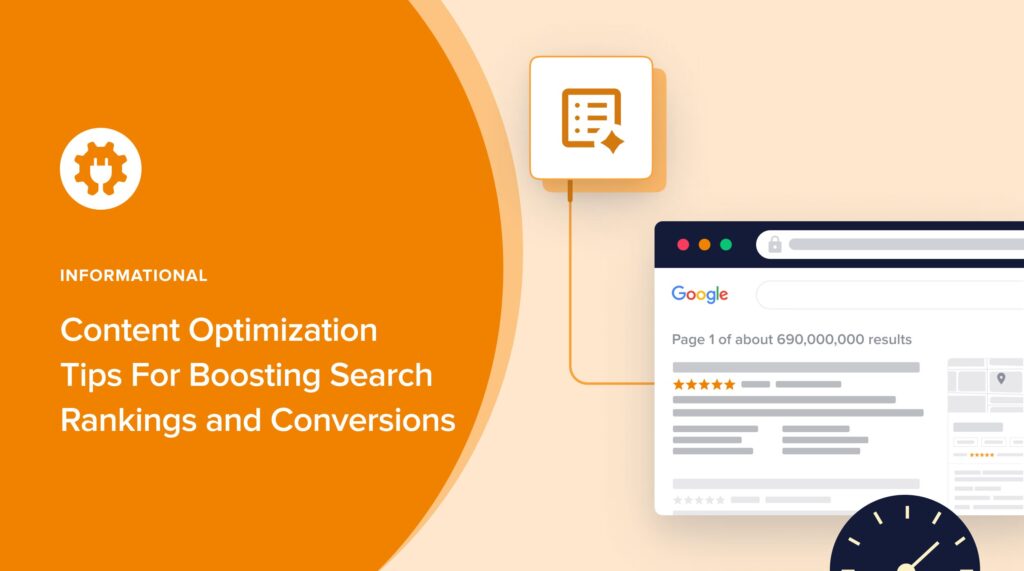Looking for no-fluff content optimization tips?
If you’re struggling to rank your content, all your online efforts are in vain. After all, if no one sees your content, you’ll have zero traffic and sales.
But it shouldn’t be like that. While competition online is stiff, you can still optimize your site and content, so Google and its users love it.
In this article, we'll explore content optimization tips and why optimizing your content matters. We’ll also provide actionable tips to supercharge your content marketing efforts.
In This Article
- What is Content Optimization?
- The Benefits of Content Optimization
- Content Optimization: Tips for Impactful Content
- 1. Use the Content Optimization Tools
- 2. Understand Your Target Audience
- 3. Conduct Keyword Research
- 4. Nail Search Intent
- 5. Run a Content Audit
- 6. Understand Semantics and Semantic SEO
- 7. Craft Compelling Titles and Headlines
- 8. Focus on Readability and Structure
- 9. Use AI to Speed Up Metadata Creation
- 10. Build Strategic Internal Links
- 11. Focus on On-page SEO Content Optimization
- 12. Create Topic Clusters
- 13. Don’t Forget Author SEO
- 14. Incorporate Visuals
- 15. Leverage AI Content Optimization Tools
- 1. Use the Content Optimization Tools
- Content Optimization Tips: Your FAQs Answered
What is Content Optimization?
Content optimization is the process of tweaking and refining your web content to maximize its performance in search engines and with users. This is often done to help you achieve specific goals for your brand.
Content optimization plays a huge role in helping your digital marketing strategy produce impactful results.
While creating high-quality content is critical, optimizing it can take it to the next level in driving more organic traffic, increasing visibility, and converting website visitors.
Content optimization involves tactics like:
- Incorporating relevant keywords and semantically related terms
- Structuring content for optimal readability and engagement
- Aligning content with the specific informational needs of your audience
- Adhering to on-page SEO best practices
- Continuously refreshing and updating existing content
We’ll look at these elements in greater detail in a moment.
The Benefits of Content Optimization
Content optimization stretches your content marketing investment, enabling you to get a better return on investment (ROI) for your efforts. By tailoring your content for search visibility and shareability, you expose your brand to a larger potential audience.
By implementing a content optimization strategy, you can unlock a multitude of benefits, including:
- Get more mileage from your content marketing: Optimized content performs better in search results, leading to increased organic traffic, engagement, and leads.
- Boost your SEO (search engine optimization): Search engines deeply analyze on-page elements like content quality, structure, keyword usage, and multimedia when ranking pages. Optimized content increases your chances of prominent ranking for relevant queries.
- Meet search intent: Optimizing for search intent ensures your content directly answers what users are searching for, leading to higher engagement, conversions, and a better overall user experience.
- Target specific business goals: Whether you want to generate leads, drive sales, or establish brand authority, content optimization can be customized to align with your specific business objectives.
If you want your online presence to be impactful, you must invest time and resources into applying these content optimization tips.
Content Optimization: Tips for Impactful Content
Now that you understand the power of content optimization, let's delve into some actionable tips to optimize your content for maximum impact:
1. Use the Content Optimization Tools
To optimize your SEO content, you need to use the right tools. And at AIOSEO, we have 2 such tools:
- All In One SEO (AIOSEO)
- SEOBoost
Here’s a brief summary of the content optimization capabilities of each:
Using AIOSEO for Content Optimization
One of the first content optimization tips is to ensure you have the right SEO tool. For WordPress users, there’s no better tool than All In One SEO (AIOSEO).

AIOSEO is a powerful WordPress SEO plugin boasting 3+ million active users. Many marketers and bloggers trust the plugin to help them boost their search engine rankings and traffic. That’s because the plugin has many powerful features and modules designed to help you properly configure your SEO settings.
When it comes to content optimization, some of the modules you’ll find helpful include:
TruSEO Analysis
AIOSEO’s TruSEO On-page Analysis gives you a score of how well-optimized your content is.
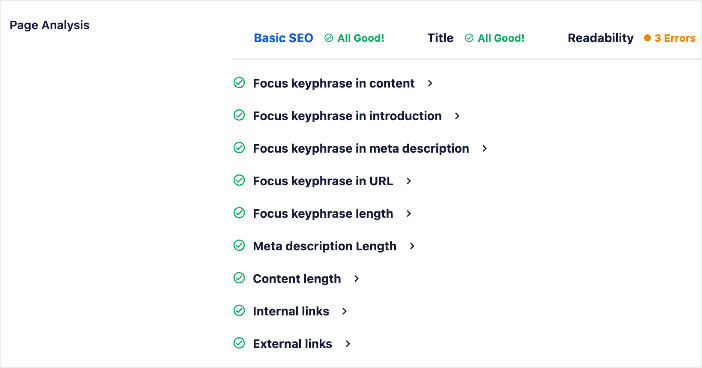
It even gives you recommendations for improving your it.
TruSEO Highlighter
AIOSEO’s TruSEO Highlighter is a great tool that helps you nail your on-page SEO on the fly.

The TruSEO Highlighter analyzes your page content and makes readability recommendations. It also highlights items that need fixing, including:
- Subheading distribution
- Passive voice
- Transition words
This cool feature also gives you recommendations for fixing any on-page SEO errors it finds.
Link Assistant
Link Assistant is a tool that crawls your site and gives a report of all the links on your site.
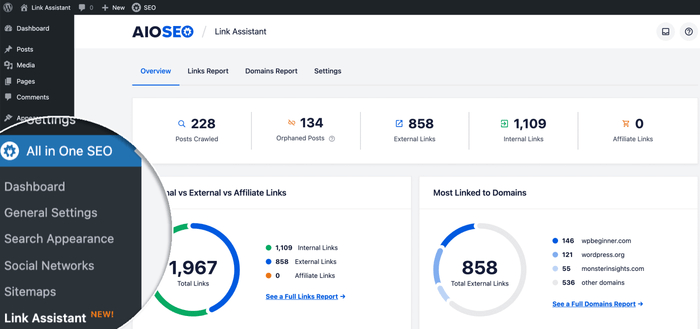
This is important because internal links play a huge role in content optimization. They help distribute link juice, improve crawling and indexing, and help keep readers on your site longer.
Link Assistant gives you a Links Report that shows you internal linking suggestions and your site's orphan pages.

The best part is that you don’t even need to open a post to add the links. You can just do so from the Link Assistant dashboard.
For step-by-step instructions on how to install AIOSEO, check our detailed installation guide.
Using SEOBoost for Content Optimization
Another content optimization tool to consider is SEOBoost. This revolutionary tool scrapes search engine results pages (SERPs) and pulls up the main keywords in the top-ranking posts.

SEOBoost is a full-suite content management platform that can be used to:
- Create content briefs and outlines
- Create topic reports
- Conduct content audits
- Use AI to speed up content optimization
It also gives recommendations on how to better optimize your content.
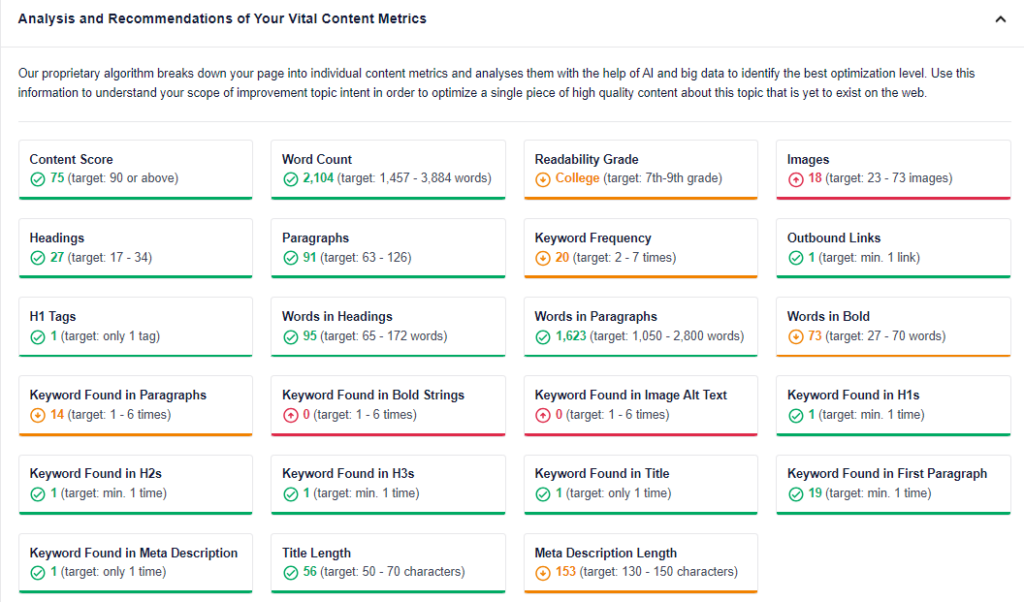
The tool even has a feature that helps you manage media more easily when optimizing your content.
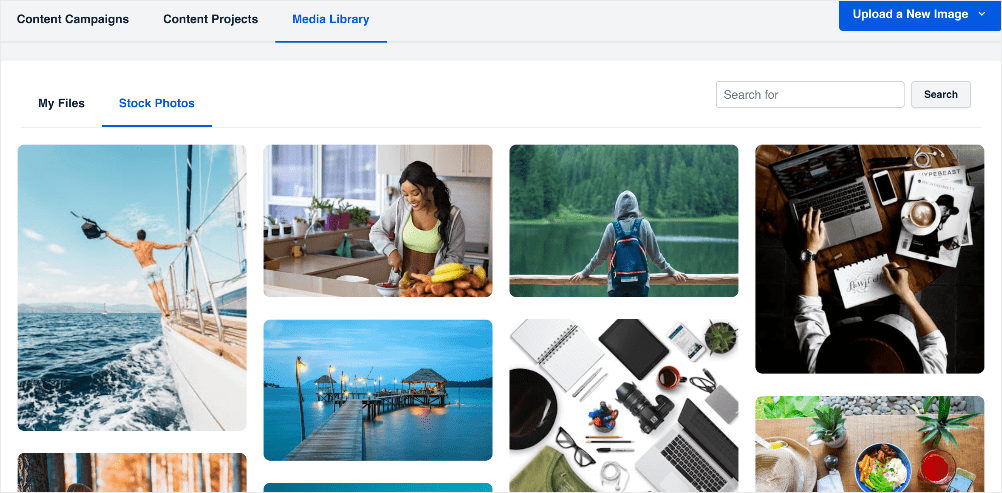
Check out the full power of SEOBoost here.
This is definitely one tool that can help you implement most content optimization tips in this article.
2. Understand Your Target Audience
Another essential aspect of impactful content optimization is audience research. His involves asking questions like:
- Who is your intended audience?
- What problems are they likely to have?
- What solutions are they looking for?
- Do they have a particular way of speaking (lingo)?
Answering these questions will give you the foundation you need to conduct impactful keyword research. It also helps you create personalized, optimized content. As a result, you’ll rank higher in search and earn the trust of your audience.
Once you’ve collected the data from your audience research, use it to create a buyer persona. This persona represents your general audience. Having a buyer persona helps you create content tailored to meet that persona's needs. The more you customize content for your core audiences, the more relevant and valuable it will be.
3. Conduct Keyword Research
Proper keyword research is one of the most important SEO growth hacks to help boost your online visibility. It involves identifying the words and phrases your target audience uses to find your blog content, products, or services. You can use many tools for this, including Ahrefs, Semrush, and more.
If you’re in a competitive niche, you’ll have better success at targeting long-tail keywords as they have lower keyword difficulty.
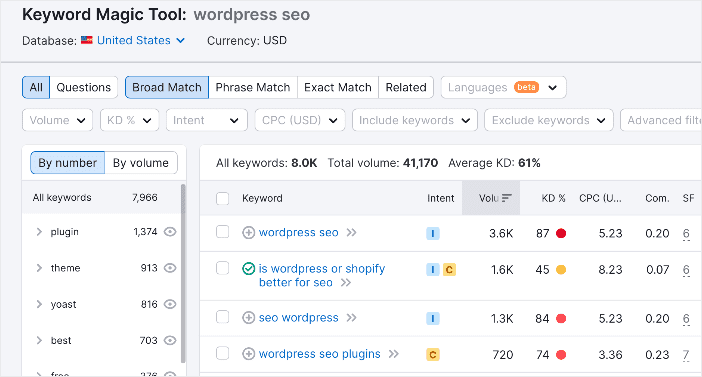
Check out our list of recommended keyword research tools here.
Besides finding the right keywords, you should know how to use them strategically. A few ways include adding your focus keyword to your:
- Headline
- SEO title
- Meta description
- Introduction and conclusion
- Headers (H1, H2, H3, etc.)
- URL
However, you should avoid keyword stuffing, which is the overuse of your keyword. Instead, opt for synonyms and other LSI keywords.
4. Nail Search Intent
Besides identifying the right keywords, you should also ensure you understand the search intent behind those keywords. Search intent refers to the main goal a user wants to achieve with the search query. The main 4 intent types include:
- Informational: Refers to the searches made to get information about a product or service.
- Navigational: People with this type of intent are looking for a specific website or webpage.
- Transactional: Users with this intent search to buy something at that moment.
- Commercial: This type refers to searches made to buy in the near future.
While it may sound complicated, figuring out search intent is quite easy. Two of the best ways to do it include:
- Use tools: keyword research tools like Semrush have a search intent feature that helps highlight the most common user intent behind a keyword.
- Study SERPs: Study the SERPs and see the type of content that ranks well.
Once you understand search intent, creating helpful content for your readers becomes easier. This results in better search rankings and engagement.
5. Run a Content Audit
A content audit is the process of systematically reviewing and analyzing the content on a website to assess its quality, performance, and relevance to the target audience. It helps identify which content to keep, update, or remove and informs future content strategy.
The easiest way to run a content audit is to use a tool like SEOBoost. Simply input the URL of the page you want to audit.

SEOBoost will analyze it for you and recommend improvements. Once the audit is complete and you’ve analyzed the data, click the Optimize Content button.

This will take you to a page where you can use the content audit results to optimize your content.
Running content audits is one of the most important content optimization tips. It helps you understand the strengths and weaknesses of your existing content, ensuring you make informed decisions about content creation and optimization and that your content efforts are aligned with your overall business and SEO goals.
6. Understand Semantics and Semantic SEO
Semantics refers to the study of how words relate to each other and their meaning in context. It’s about understanding the relationships between phrases, words, and topics
In the context of SEO, semantics acknowledges that search engines don't simply match keywords. Those days are long gone. Instead, they strive to understand a search query's overall theme and intent.
Semantic SEO involves incorporating synonyms, related terminology, and conceptually relevant phrases throughout your content. This reinforces relevance signals to search engines about what your page is truly about at a deeper topical level. For example, let’s say you're writing about dog training. Some of the semantic keywords you’d incorporate into your content may include “puppy obedience,” “canine behavior,” “positive reinforcement methods,” and other pet-related terms. This shows search engines that your content pertains to that overarching topic sphere.
While it may sound daunting, identifying semantic keywords is easy. You can do this by:
- Using tools like Semrush's Topic Research or Clearscope's Related Terms report
- Reviewing the “People also ask” and auto-suggested searches in Google
- Looking at the terminology used across the top-ranking pages for your target keywords
Understanding semantic SEO and implementing it is a great content optimization hack you should use. Doing so helps search engines fully understand your content's topics, framing it as an authority source to potentially rank higher.
7. Craft Compelling Titles and Headlines
Your title is the first impression users have of your content. Consider it like a movie trailer; it should be clear, concise, and engaging enough to entice viewers to click and consume the rest of your content.

Don’t worry, you don’t have to be a great script writer to craft compelling headlines. Just follow the tips below:
- Keyword integration: While not the sole focus, strategically incorporate your target keyword at the beginning of your title for optimal SEO value.
- Clarity and concision: Keep it short and sweet. Aim for titles between 50-60 characters to ensure full visibility in search results.
- Benefit-driven: Highlight the value proposition of your content. What will users gain from your content?
- Curiosity factor: Spark user interest with a question, surprising fact, or intriguing statement.
- Numbers and power words: Numbered headlines, like “5 Tips” or “Top 10,” grab attention. On the other hand, power words like “ultimate,” “secret,” or “essential” create a sense of urgency.
- Readability and appeal: Maintain a conversational tone and avoid jargon. Use active voice and strong verbs to make your title impactful.
By following these tips, you can craft titles that are both SEO-friendly and irresistible to users, boosting your click-through rates and overall content performance.
Pro tip: Use AI to automatically generate titles and headlines for your content.
8. Focus on Readability and Structure
Readability and structure are other content optimization tips you should follow. This means formatting your content so that it’s scannable and easy to read. Poor structure with dense walls of text is a sure way to have visitors quickly bounce from your pages. On the other hand, smart formatting makes your content look inviting and effortless to digest.
To optimize content structure and readability:
Use Descriptive Headings and Subheadings
Break up your content into clear sections with H2 and H3 subheads. Headings should summarize the key points covered in each section using common keyword phrases and speaking to the “jobs” readers want to get done.
Keep Paragraphs Short and Punchy
Limit paragraphs to 3-4 sentences at most. Shorter paragraphs with a single concept per paragraph are much easier to scan and read. Just like this one 🙂.
Implement Vertical White Space
Plentiful line breaks between paragraphs and headings help create visual breathing room, preventing intimidating text dumps.
Utilize Bulleted and Numbered Lists
Where possible, break up information into easy-to-consume bullet points or numbered lists. These quickly convey opportunities and actionable takeaways.
Embrace Multimedia and Visual Aids
Incorporate supportive images, videos, charts, graphics, gifs, and other multimedia elements. These can reinforce key points while breaking up text walls.
By prioritizing readability and scannable structure, you'll keep visitors engaged, reduce bounce rates, and improve content effectiveness. This is definitely one of the most important content optimization tips if you want to boost engagement.
9. Use AI to Speed Up Metadata Creation
Metadata like SEO titles and meta descriptions are essential in helping you boost your rankings and organic clickthrough rates. These, and the URL, make up the greater portion of your snippet on search listings.
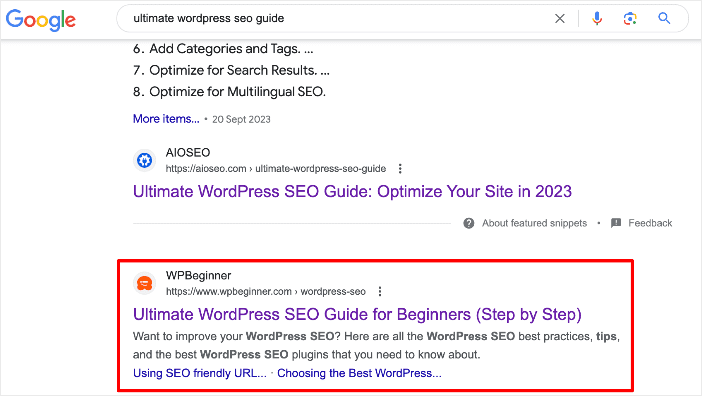
AI content tools can automatically generate optimized meta descriptions, headers, image alts and more, saving time while boosting on-page elements.
Well-crafted metadata must:
- Include the focus keyword
- Meet search intent
- Be descriptive
Particularly if you publish many pages, crafting SEO-friendly title tags and meta descriptions can take up a lot of time. That’s why you should speed this process up with an AI-powered tool. There are many toos like ChatGPT, Claude, and others to help with this. The only caveat is you’ll have to copy and paste onto your pages.
The best solution is to use AIOSEO’s AI Title/Description Generator.
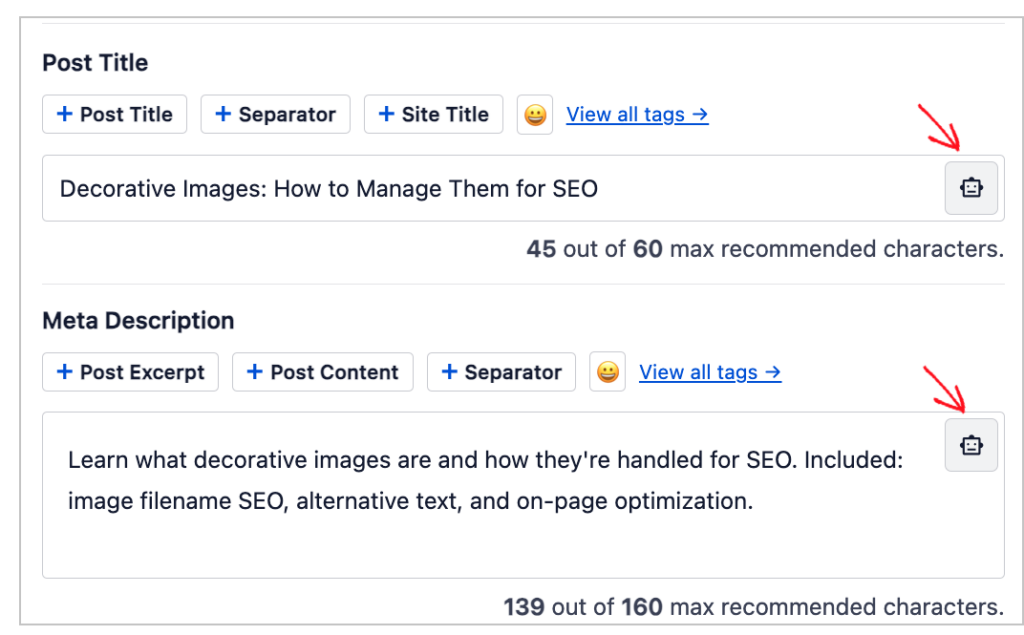
Clicking on the robot icon next to the Post Title and Meta Description fields generates 5 suggestions that you can use.
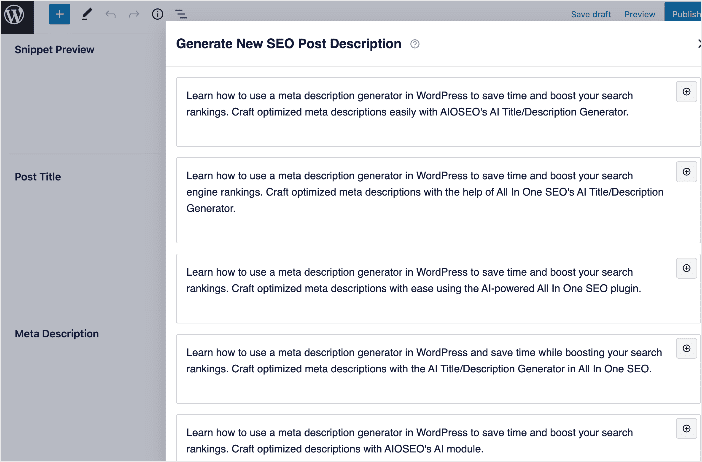
Simply click on the version you want to use and you have your meta description or title tag with just the click of a button. This will help speed up the content optimization process, giving you time for other tasks.
10. Build Strategic Internal Links
Internal links are links between pages on the same site. Building them is a powerful content optimization and SEO practice as it helps:
- Keep readers on your site for longer
- Distributes “link juice” across your site
- Search engines better understand what your site is about
- Improve crawling and indexing
- Improve site navigation
The biggest challenge of building internal links is that remembering all the pages you can interlink becomes difficult as your site grows. This is why you should use an internal linking tool like AIOSEO’s Link Assistant.
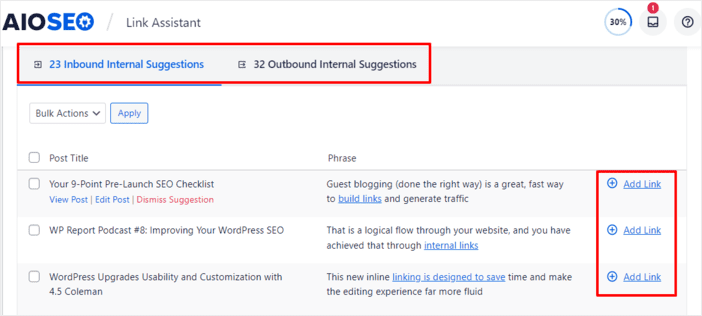
Link Assistant is a powerful tool that helps you build strategic internal links with just a few clicks of a button. It also helps you find and fix orphan pages on your site, which are pages without any internal links and are poorly optimized.
With Link Assistant, adding internal links is fast and easy. It will suggest which articles to link to and the anchor text to use. You can include all link suggestions at once or add them individually as you vet them.
No list of the best content optimization tips can be complete without this key strategy.
11. Focus on On-page SEO Content Optimization
The main essence of content optimization is getting your on-page SEO right. Thankfully, the days of manually going through your content with a fine-tooth comb to optimize it are behind us. You can now leverage tools like SEOBoost to get this done in a few minutes.
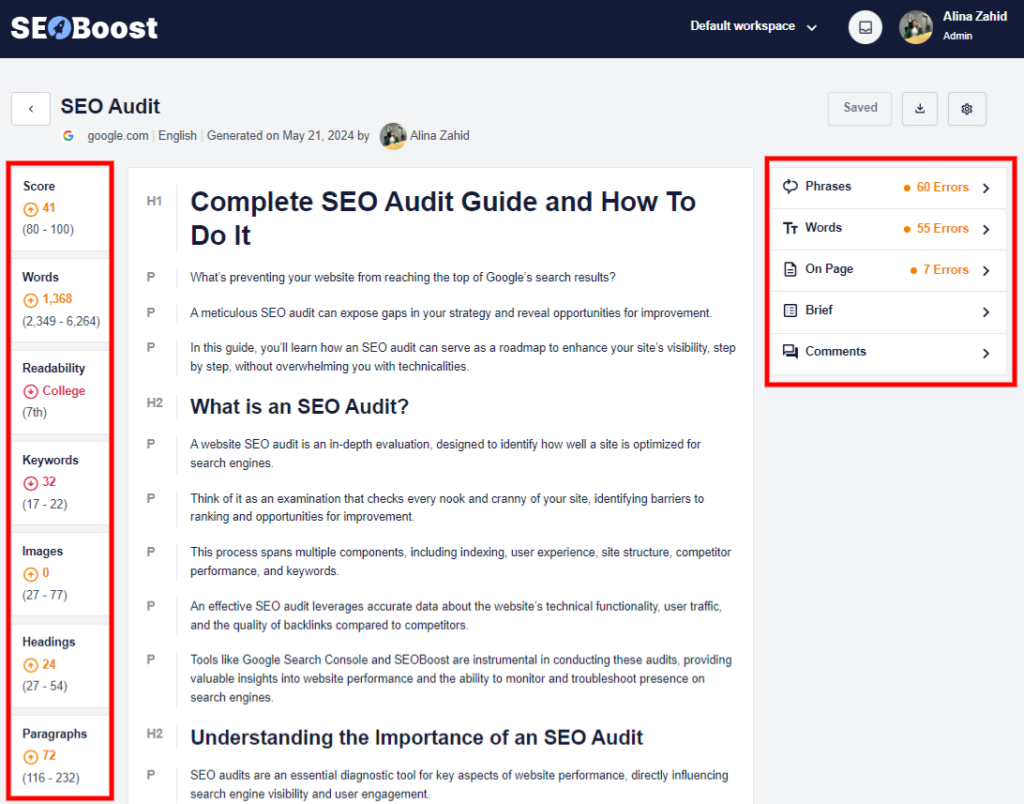
This is the fastest way to ensure your content is primed to meet the on-page SEO standards for that keyword. SEOBoost helps ensure you:
- Meet the right word count
- Ensure your content is scannable and has a good readability score
- Optimal keyword usage
- Proper image use
- And more
These are all important as on-page SEO helps ensure that your content is tailored to the user's search intent. It also signals to search engines that your content is relevant for the search queries user make. This helps them index it properly resulting in improved search rankings.
12. Create Topic Clusters
The topic cluster model is a highly effective way to build topical authority and enhance your overall content optimization efforts. The concept involves developing a comprehensive pillar page around a broad core topic and then creating multiple related pieces of supporting content that link back to the pillar and cover subtopics in more depth.
This content strategy confers several key advantages, including that it:
- Reinforces the relevance of your core topics to search engines through interlinking related content.
- Allows you to comprehensively cover a topic area from multiple angles for users.
- Improves internal linking structure and navigation pathways across your site.
- Helps you map out a cohesive content plan and editorial calendar.
Implementing a topic cluster strategy requires 2 main components:
Pillar Pages (Cornerstone Content)
Pillar pages, also called cornerstone content, serve as the centerpiece, providing a high-level overview of the core topic. These pieces of cornerstone content should be highly detailed and in-depth, touching on all the important subtopics and semantically related concepts.
With AIOSEO’s revolutionary Cornerstone Content feature, you can easily mark your pillar pages as cornerstone content for easier content management.
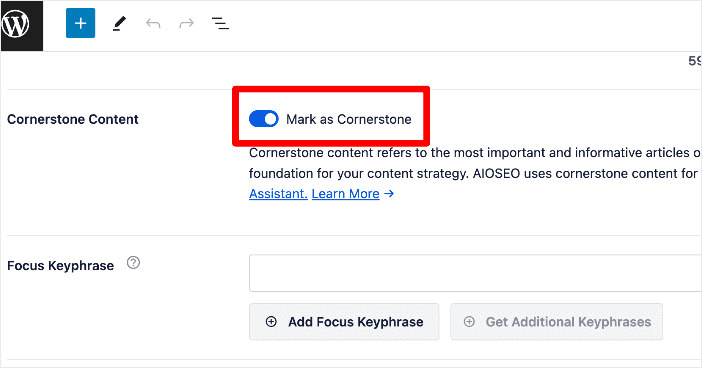
Marking your post or page as cornerstone content also adds it to a new post list filter dedicated to cornerstone content.
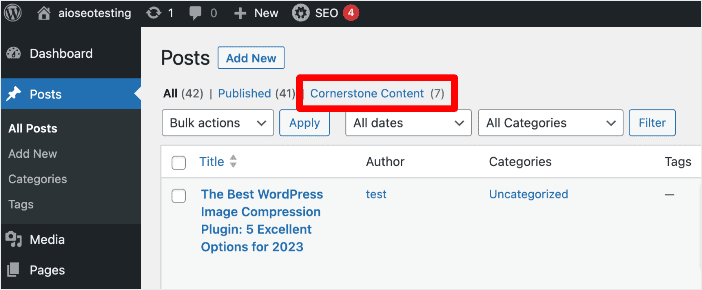
This filter lets you see your important pages at a glance, making it easier to create links to them.
Subtopic Pages
Subtopic pages are supporting pages that explore particular subtopics in granular detail. Each cluster page should focus on a specific angle related back to the main subject explored in the pillar. For example, a pillar page about “dog training” may have cluster content diving deeper into subjects like “crate training puppies,” “teaching basic commands,” “leash training tips,” and other relevant subsections of the overarching topic.
Properly interlinking the pillar and cluster pieces is crucial. The pillar page should link to each supporting cluster article. Each cluster content page should link back to the main pillar page while potentially crosslinking to other tightly related cluster content as well.
This creates a cohesive topic cluster that demonstrates completeness around a core focus area.
By building out in-depth topic clusters optimized around high-value keywords and searcher needs, you can elevate your content's authority, improve navigation experiences, and rank higher across your target topics. This is why this is one of the top content optimization tips that can help boost your search rankings.
13. Don’t Forget Author SEO
Author SEO is the practice of optimizing your online presence to improve your visibility in search engine results pages (SERPs) when people search for your name or work. It’s also essential in helping you rank your content for the topics you write about, particularly in YMYL (your money, your life) niches.
To help you do this, you should demonstrate Google’s E-E-A-T content quality guidelines. FYI, E-E-A-T is an acronym for:
- Experience: refers to the first-hand experiences the author or other team members have with that particular topic.
- Expertise: refers to the expertise of the creator of the main content.
- Authoritativeness: refers to the authoritativeness of the main content creator, the content, and the website the content is published on.
- Trustworthiness: Refers to the trustworthiness of the main content creator, the content itself, and the website it’s published on.
Demonstrating these is easier with AIOSEO’s Author SEO module.
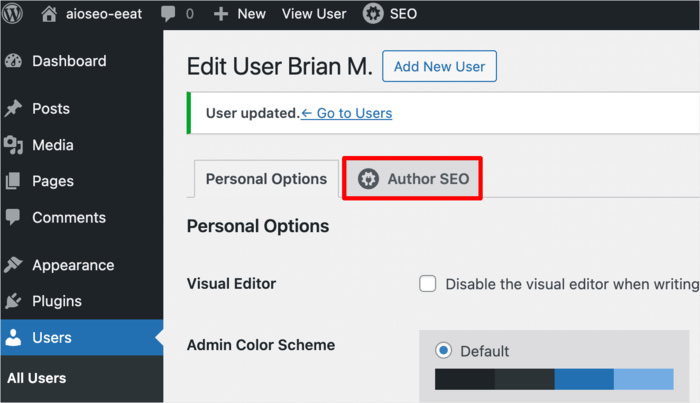
This module enables you to add information to your user profiles:
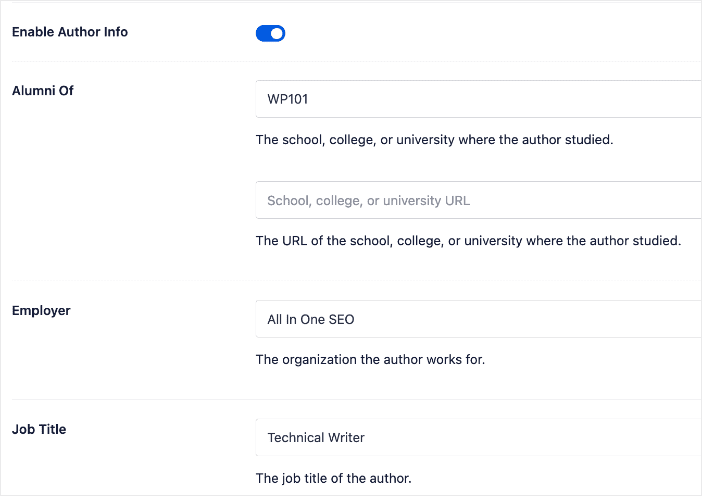
You can also add your areas of expertise:

All this information points to your E-E-A-T. Coupled with the JSON schema markup, it proves to search engines that you’re qualified to talk about the subject. This helps you rank higher in searches around your keyword.
Improving your Author SEO is undoubtedly one of the top content optimization tips you shouldn't ignore.
14. Incorporate Visuals
Images are a great addition to your blog content. They help keep readers engaged and make it easier to show users what you’re talking about. The latter is especially important when the topic is complex.
However, your images can slow down your site and negatively impact your SEO if not handled correctly. That’s why you must pay attention to image SEO.
One of the best ways to optimize your images is by compressing them. This shrinks image files without reducing the quality. That’s why we suggest compressing images before uploading them to WordPress.
Along with compressing images, you should also:
- Use strategic file names: This means your filenames should be descriptive and, if possible, contain your keyword.
- Add alt text: Alt text stands for “alternative text.” Sometimes called alt tags, this text explains to search engines and visually impaired readers what the image is about.
Check out our image SEO guide for detailed information on content optimization tips for images.
15. Leverage AI Content Optimization Tools
Content optimization tools are plugins and software that help you improve the speed of execution and the efficiency of your content optimization process. Otherwise, doing so would mean spending hours optimizing a single piece of content. Content optimization tools can help:
- Enhance your content’s visibility on SERPs
- Ensuring all your relevant keywords are included in your article
- Improving readability
- Include relevant external and internal links
- And more
Today’s content optimization tools are more powerful, thanks to AI technology. Besides SEOBoost, other examples of AI-powered content optimization tools you should consider include:
Clearscope
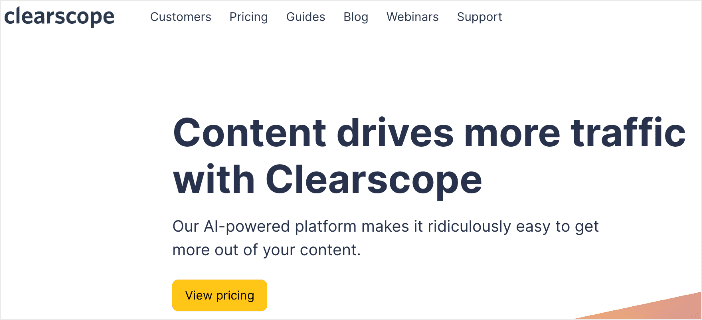
Clearscope uses natural language processing to analyze the top-ranking search results for your target keywords. It provides a comprehensive content brief detailing all the topics, keywords, semantically related terms, and more that you should cover to create competitive content. As you write, it scores your draft in real-time against the top results.
Frase

Frase uses AI to automatically generate rich content briefs and outlines based on search data. It surfaces related topics, query clusters, and insights to inform what you should cover. The AI can even assist or fully draft content customized to the provided guidance, making content creation super easy.
Grammarly

Grammarly is another content optimization tool you should consider adding to your arsenal. It’s a fantastic tool that helps ensure your content is free of grammatical and spelling errors.
The tool also helps improve sentence structure and readability, reduces passive voice in writing, and enhances conciseness. All this makes your content a pleasure to read, resulting in more return visitors and higher dwell times.
Content Optimization Tips: Your FAQs Answered
What is the difference between content optimization and SEO?
SEO is a broad strategy that encompasses content optimization. Content optimization focuses on improving individual content pieces for search engines and conversions.
What is the best way to optimize content?
Focus on quality, keyword optimization, search intent alignment, clean structure/formatting, multimedia integration, and technical on-page factors. You can't go wrong with these content optimization tips.
What are the top content optimization tips to help boost search rankings?
Some of the top content optimization tips include:
- Using the right content optimization tool
- Understanding your target audience
- Running content audits
We hope this post has helped you know some of the top content optimization tips you can use to boost your search rankings. You may also want to check out other articles on our blog, like our guide to common SEO mistakes to avoid or our article on the benefits of SEO for small businesses.
If you found this article helpful, then please subscribe to our YouTube Channel. You’ll find many more helpful tutorials there. You can also follow us on X (Twitter), LinkedIn, or Facebook to stay in the loop.
Disclosure: Our content is reader-supported. This means if you click on some of our links, then we may earn a commission. We only recommend products that we believe will add value to our readers.
